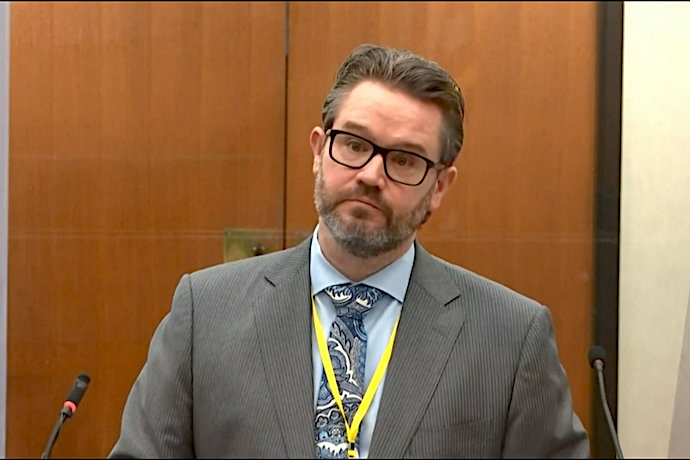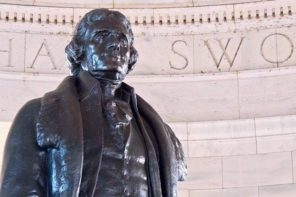On the first day of the George Floyd trial, Eric Nelson, the attorney for Minneapolis police officer Derek Chauvin who kneeled on Floyd’s neck for 8 minutes 46 seconds, disputed the independent pathologists’ report that simple asphyxiation—a loss of oxygen—had killed Floyd in May 2020. Mr. Nelson argued that it was a complex process made even more complicated by Floyd’s use of fentanyl and by the “adrenaline flowing through his body.” This is also why the defense wanted the judge to rule as admissible body-cam footage of an unrelated 2019 traffic stop, in which Floyd swallowed eight Percocet pills after he was pulled over.
Establishing a glimmer of doubt for jurors with respect to what exactly made Floyd’s heart stop—was it Chauvin’s knee or a preexisting drug-addiction?—is clearly a central piece of the defense’s legal strategy. The question of whether it will succeed remains to be seen. But what is clear is that this strategy is as much a reflection of the weakness of the defense’s position as it is of our racist history in which Black people who’ve been killed are criminalized and painted as uncivil citizens to be feared and who are themselves responsible for their own deaths.
The defense’s turn to Floyd’s drug use specifically is part of a more recent pattern. Consider how the defense attorney for Darren Wilson, the police officer who shot and killed Michael Brown, the Ferguson, Missouri teen in 2014, spent hours telling the grand jury that Brown, who was Black, had a high dose of the active ingredient of Marijuana, THC, in his system. Or how the Dearborn Heights, Michigan man, Theodore Wafer, who shot and killed Renisha McBride at point blank range with a shotgun in 2014, tried to convince the jury that, given that her blood alcohol level was .22, he was simply acting in self-defense.
The Ferguson grand jury didn’t indict Wilson, though Wafer was sent to prison. What’s remarkable isn’t the difference in result, but the repeated attempt by the defense in these cases to play on racist ideas of presumptive Black criminality, or what Harvard professor, Khalil Gibran Muhammad calls the “Condemnation of Blackness.” Somehow, the salient issue isn’t that defenseless, unarmed Black people are killed, but that they’re imagined to have a prior history that speaks to an uncivil character. This serves as evidence to exonerate their killers, or, at the very least, to make the jury empathize with the killer, rather than the victim.
Rendering Black people uncivil is but a modern update to an old story. White lynch mobs in the 1890s falsely claimed that Black men were engaged in sexual assault against white women throughout Mississippi, Georgia, and Tennessee—this became their justification for murdering them in cold blood in the dead of night.
When a white militia of 2,000 destroyed the thriving Black town and murdered dozens in Wilmington, North Carolina, replete with a Black newspaper and Black politicians, an enthusiastic defender of the massacre, Alfred Waddell, who would become mayor of Wilmington explained that it was to restore civility in the southern town: “I believe the [Black residents] are as much rejoiced as the white people that order has been evolved out of chaos.”
Think back to 1955, when Carolyn Bryant, the white woman who owned a store in Money, Mississippi, told an all-white jury in the trial of J.W. Milam and Roy Bryant, who had lynched a fourteen-year-old African-American boy, Emmett Till, that he had made “ugly remarks,” to her. The jury took 67 minutes to find the two men innocent.
Don’t believe your eyes; accept the racist myth of Black incivility. This is, at least implicitly, what Derek Chauvin’s defense attorney is trying to tell the jury. And what this time-honored strategy illustrates is that depictions of Black unruliness, illegality, impoliteness, violence, and danger are effective for distracting attention from the real issue at hand. The real issue is how many white people throughout U.S. history have felt it to be their sovereign right to decide which Black people are threatening and which aren’t—and then to act on it.
Think of the seventeen-year-old, Trayvon Martin, who was murdered in 2012 by a neighborhood watchman, George Zimmerman, because he was presumed to be a menace by virtue of wearing a hoodie and strolling through a gated community. As Zimmerman told a 911 dispatcher, “these assholes always get away.” Or the Black birder, Christian Cooper, in Central Park in the summer of 2020, who was falsely accused by a white woman of “threatening” her. His threat? Asking her to keep her dog on a leash.
Recall in 2018 when police were marshalled by white people as Black people were barbequing in Oakland, visiting a Starbucks in Philadelphia, or studying for graduate exams at Yale University. Who is civil and who is not isn’t a matter of science, but of perception. And given that the rules of decorum are settled by white people, racist outcomes are the norm, rather than the exception.
We don’t yet know whether the jury will find Chauvin guilty, and if so, on which charges. But we do know that George Floyd’s tragic death sparked one of the greatest global antiracist movements in modern U.S. history. Let’s hope that, whatever the outcome of the trial, antiracist activists will continue to work—as they always have—to abolish the lie of Black incivility, and awaken Americans to its dangerous legacy.





